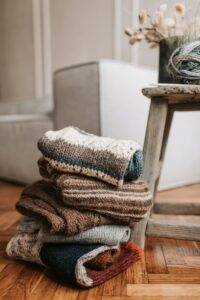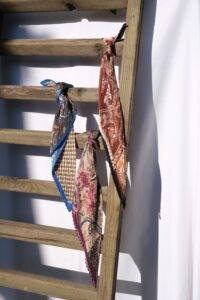 A scarf is a piece of fabric that is worn around the neck or head for warmth, cleanliness, fashion, or religious reasons. It is typically a long and narrow piece of fabric that can be made from a variety of materials, such as wool, cashmere, cotton, silk, and polyester. Some people wear scarves to protect their skin from the sun or wind, while others wear them as a fashion accessory to add colour or pattern to their outfits. Scarves can be worn in a variety of ways, including hanging loosely around the neck, wrapped around the neck several times, or tied in a knot or bow.
A scarf is a piece of fabric that is worn around the neck or head for warmth, cleanliness, fashion, or religious reasons. It is typically a long and narrow piece of fabric that can be made from a variety of materials, such as wool, cashmere, cotton, silk, and polyester. Some people wear scarves to protect their skin from the sun or wind, while others wear them as a fashion accessory to add colour or pattern to their outfits. Scarves can be worn in a variety of ways, including hanging loosely around the neck, wrapped around the neck several times, or tied in a knot or bow.
Scarves have been worn by people for thousands of years for a variety of purposes. In ancient civilizations, scarves were worn for warmth, protection from the elements, and as a symbol of status or religious beliefs. In ancient Egypt, for example, scarves were worn by both men and women as a form of protection from the sun and sand. In ancient Rome, scarves were worn by soldiers to wipe sweat and dust from their faces.
During the Middle Ages, scarves were worn by both men and women as a form of head covering, and they were often made from wool or linen. In the 17th and 18th centuries, scarves became a popular fashion accessory for both men and women, and they were often made from luxurious materials such as silk or cashmere. Today, scarves are worn by people all over the world for both practical and fashionable reasons. They come in a wide variety of styles, colours, and materials, and they can be worn by people of all ages and genders.
Scarves have been known to be used for religious purposes in a number of different cultures and religions. In Hinduism, the scarf is known as a dupatta and is worn by women as a symbol of modesty and piety. In Sikhism, the scarf is known as a dastaar and is worn by men as a symbol of their faith. In Islam, both men and women may wear scarves as a symbol of modesty and piety. For men, this is typically in the form of a turban, while for women it is often a headscarf known as a hijab. In Christianity, some priests and bishops wear a scarf known as a pectoral cross, which is a large cross that is worn around the neck and is often made from gold or silver. In addition to these religious traditions, scarves have also been worn for spiritual and cultural reasons by indigenous people in many parts of the world.
In Judaism too, large scarves (Talit) are used by men while praying and are worn in a particular way around the shoulders and head during prayer time. Different Jewish communities have different customs that relate to the way the Talit is worn or the shape and colours. Religious women use it as a form of head covering during prayer or while visiting a synagogue. The head covering, known as a tichel or mitpachat in Hebrew, is worn by some Jewish women as a sign of modesty and as a way to fulfil the traditional commandment for married women to cover their hair. The scarf can be worn in a variety of styles, such as wrapped around the head and secured with a clip or pinned in place, or it can be draped over the head and shoulders. Some Jewish women also choose to wear a scarf as a way to express their cultural or spiritual identity.
communities have different customs that relate to the way the Talit is worn or the shape and colours. Religious women use it as a form of head covering during prayer or while visiting a synagogue. The head covering, known as a tichel or mitpachat in Hebrew, is worn by some Jewish women as a sign of modesty and as a way to fulfil the traditional commandment for married women to cover their hair. The scarf can be worn in a variety of styles, such as wrapped around the head and secured with a clip or pinned in place, or it can be draped over the head and shoulders. Some Jewish women also choose to wear a scarf as a way to express their cultural or spiritual identity.
In Europe, scarves have been worn for a variety of purposes throughout history. In the Middle Ages, scarves were worn by both men and women as a form of head covering and for warmth. During the 17th and 18th centuries, scarves became a popular fashion accessory for both men and women, and they were often made from luxurious materials such as silk or cashmere. In other European countries, scarves have been worn as a symbol of national or cultural identity, such as the Scottish tartan or the Irish shawl. Today, scarves are still worn in Europe for both practical and fashionable purposes, and they come in a wide variety of styles, colours, and materials.
 Scarves have been a part of English history for many centuries. In the Middle Ages, scarves were worn by both men and women as a form of head covering and for warmth. In the 19th and 20th centuries, scarves continued to be popular in England, and they were worn by both men and women as a fashion accessories or for practical purposes such as keeping warm. Today, scarves are still a popular item in England, and they are worn by people of all ages and genders for both practical and fashionable reasons. The British army adopted scarves into their uniform too and the type of scarf worn depends on the regiment or corps, and the scarves are often referred to as “regimental scarves.” Each regiment or corps has its own distinctive scarf, which is typically made from wool and is worn around the neck for warmth. Some examples of regimental scarves include the Royal Tank Regiment scarf, the Royal Corps of Signals scarf, and the Royal Artillery scarf. In addition to being worn as part of the uniform, these scarves are also often worn by former members of the regiment or corps as a symbol of pride and membership.
Scarves have been a part of English history for many centuries. In the Middle Ages, scarves were worn by both men and women as a form of head covering and for warmth. In the 19th and 20th centuries, scarves continued to be popular in England, and they were worn by both men and women as a fashion accessories or for practical purposes such as keeping warm. Today, scarves are still a popular item in England, and they are worn by people of all ages and genders for both practical and fashionable reasons. The British army adopted scarves into their uniform too and the type of scarf worn depends on the regiment or corps, and the scarves are often referred to as “regimental scarves.” Each regiment or corps has its own distinctive scarf, which is typically made from wool and is worn around the neck for warmth. Some examples of regimental scarves include the Royal Tank Regiment scarf, the Royal Corps of Signals scarf, and the Royal Artillery scarf. In addition to being worn as part of the uniform, these scarves are also often worn by former members of the regiment or corps as a symbol of pride and membership.
Yes, scarves are still a popular fashion accessory today. They are worn by people all over the world as a way to add colour, pattern, or texture to an outfit, and they can be made from a wide variety of materials such as wool, cashmere, silk, cotton, and polyester. Scarves can be worn in a variety of ways, such as hanging loosely around the neck, wrapped around the neck several times, or tied in a knot or bow. They can also be worn as a head covering or around the waist as a belt. In addition to being a practical item for keeping warm, scarves are also used in modern fashion to add a personal touch to an outfit or to make a statement.
